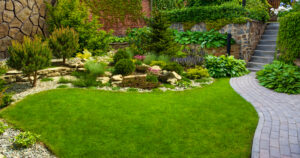
Sustainable Landscaping: Eco-Friendly Practices for a Greener Exterior
Green landscaping, also known as sustainable or eco-landscaping, is the practice of designing, building, and maintaining your landscape in a way that saves time, money, and energy. These environmentally friendly landscapes benefit animals, reduce air, soil, and water pollution, and create safe recreational areas. Green landscaping strategies may help your yard have a good environmental impact.
Landscape Plants and Hardscapes
The selection of plants is critical in green landscaping. Prioritize native plants or produced cultivars derived from native species when determining what to plant. However, it is critical to speak with local experts to ensure that you choose native plants that are neither invasive nor aggressive.
Some native plants, such as purple loosestrife, are attractive but can be hazardous because they expand too quickly into natural environments, crowding out other plant species. It is critical to establish a balance between environmental advantages and appropriate plant selection.
Flow-permeable Surfaces
One of the most ecologically friendly landscaping strategies is reducing rainwater runoff. Choose permeable surfaces that enable water to soak into the earth when designing a hardscape project.
Consider using caught rainfall or greywater in your yard as well. Permeable surfaces not only help with water filtering and minimize flow into drains and waterways, but they also give a pleasing tactile aspect with the satisfying crunch of gravel underfoot, softening the overall aesthetic of hard surfaces.
Eco-friendly Siding
Choosing ecologically friendly siding is an important step in lowering a home’s environmental impact. It has various benefits, not just for the environment, but also for the homeowner and inhabitants.
The appropriate siding may reduce a home’s carbon footprint, improve energy efficiency, offer adequate insulation, and restrict energy consumption during manufacture and installation, lowering emissions discharged into the environment. When it comes to this, it is important to get consulted professionally such as St. Louis James Hardie siding installers‘ service which will inform you of the best eco-friendly siding you can get.
Sprinkler Installation
Watering is essential in landscaping projects to keep plants and trees looking alive. Consider installing a sprinkler system instead of manually utilizing a garden hose to ensure optimum water consumption. This enables automatic watering with configurable time and application rates.
A drip irrigation system is perfect for garden beds because it delivers water to the root systems rather than the leaves, saving water and fostering deep root growth. Plants that are deeply watered are better able to endure severe winds and illnesses.
The Benefits of Mulching
Mulching serves several functions in sustainable gardening. It functions as a weed barrier, keeping undesired plants from developing, and helps maintain moisture in the soil, which is especially useful in water-stressed areas.
Apply a layer of mulch 2 to 3 inches deep to your garden beds and around landscaping plants to reap these advantages. There are several types of sustainable mulch available, including shredded bark, cocoa bean hulls, pine needles, grass clippings, and coir.
Soil Enhancement
Even when dealing with native plants, it is necessary to amend the soil since they require good soil to grow. You may build a healthy environment by routinely amending the soil, which offers necessary nutrients to your plants, whether they are flowers, shrubs, or trees. Potassium is important for overall plant health, phosphorus is important for root growth, and nitrogen is important for stem and leaf development.
Consider utilizing organic fertilizers generated from both animal and plant sources, as well as compost, when amending the soil. These additives serve to enhance the condition and texture of the soil, providing the optimum habitat for your plants.
Utilize Rainwater
Harvesting rainwater is an efficient and environmentally responsible way to keep your landscape green while decreasing water waste in your home. Install gutters to collect rainfall from the roof, preventing contaminated water from contaminating your water supply.
Rain barrels are an easy method to collect and store rainwater for use in irrigating your garden and plants later on. You can also explore rain chains or cisterns as alternatives to harvesting rainwater and improving your water efficiency.
Using Pots to Grow Plants
If you have limited yard space, such as a patio, deck, or rooftop, you can still create a lush outdoor living area by using containers for your plants. You can grow flowers that attract pollinators, cultivate vegetables or herbs, and even use potted plants to create privacy screens in these confined spaces. This allows you to make the most of your available outdoor area.
Conclusion
In conclusion, if you want to keep plants in your outside area, you should be aware that it requires time and care commitment since it is a daily effort. A green space, on the other hand, not only pleases the sight but may also provide health advantages by supplying fresh air. Follow the recommendations listed above to guarantee a smooth and effective gardening experience, and you’ll likely notice the advantages in a short time.